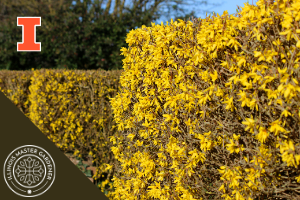Garden knowledge and practices tend to get passed down from previous generations much like family heirlooms. We are reluctant to give them up even when a controlled scientific study has proven there is a better way. The following are a few methods whose time has come and need to be gone.
Trimming specimen plants into hedges. A specimen plant is just that. Because of its structure and blooming habit, it is meant to stand alone. Forsythia, a prime example, grows up and out. Trying to turn it into a hedge will yield an uneven row with a lot of brown branches visible instead of green leaves. Most of the blooms are pruned off so the flower display is spotty.
Staking trees. While staking newly planted trees will not harm the tree as long as the stakes only remain a year, it is not necessary. Trees benefit from the buffeting of the wind to grow stronger.
Home recipes for pesticides and fertilizers using household chemicals. Commercial products are tested for a specific use, the proper dosage, and health hazards, then certified for that use. By pulling chemicals out of the pantry (yes, vinegar is still acetic acid), we are unable to determine the dosage, whether it is safe around children and pets, or what long-term effects it could have on the environment.
Mulch volcanoes around trees. Structurally, trees have three parts. The roots, the root flare, and the canopy. Only the roots should be covered up. The root flare is at the base of the trunk, spreading out wider than the upright column. Because the root flare is covered by bark, it should not remain wet over a long period as it needs to breathe. Piling mulch up against the bark keeps it too damp, inviting disease. When mulching a tree, use a donut shape, keeping the mulch off the root flare and the rest of the trunk.
Putting your gardens “to bed” in autumn. Every fall a conflict arises in homeowners' minds. We’ve read that leaving perennials standing all winter is good for nature and protects the roots, so fight the desire for neatness and that “finished” look. The spent stems of your perennials trap leaves and corn stalk debris, if you live in the country, providing an insulating layer over the roots. Those roots are now protected from rapid temperature changes and frost heaving. Beneficial insects overwinter in garden debris in various forms of their life cycle depending on the insect. The decomposing leaves add nutrients to the soil while the earthworms aerate it, coming up to feed on the organic matter.
Trying to change the way we do things can be hard, but your plants would thank you if they could. Do you have more questions about gardening the Edgar County Illinois Extension Master Gardeners can answer? Please call 217-465-8585 and leave a message. You can also access online Illinois Extension horticulture resources at go.illinois.edu/GardeningResources.
About Extension: Illinois Extension leads public outreach for University of Illinois by translating research into action plans that allow Illinois families, businesses, and community leaders to solve problems, make informed decisions, and adapt to changes and opportunities.
Source: Jan Phipps, Edgar County Master Gardener
